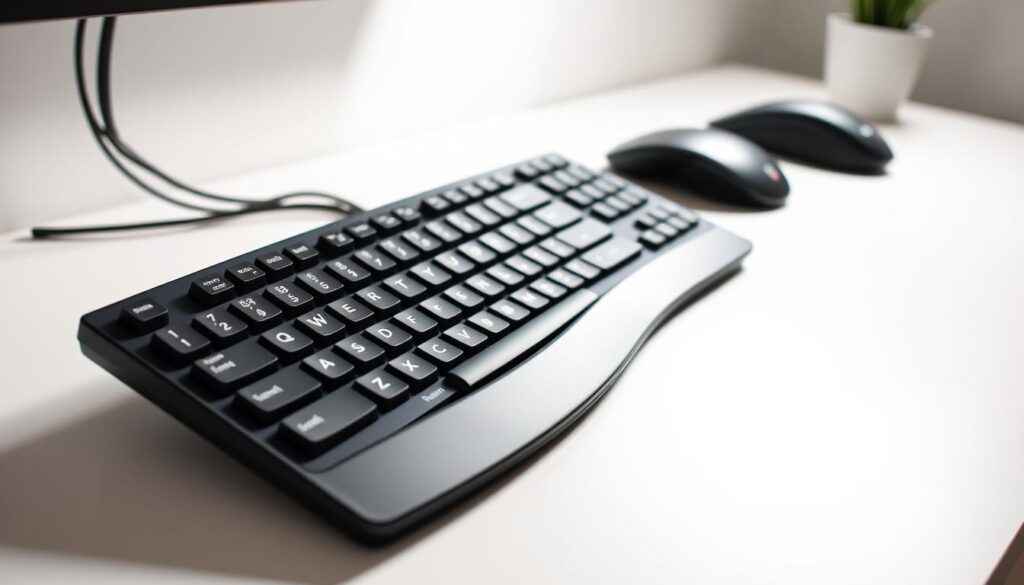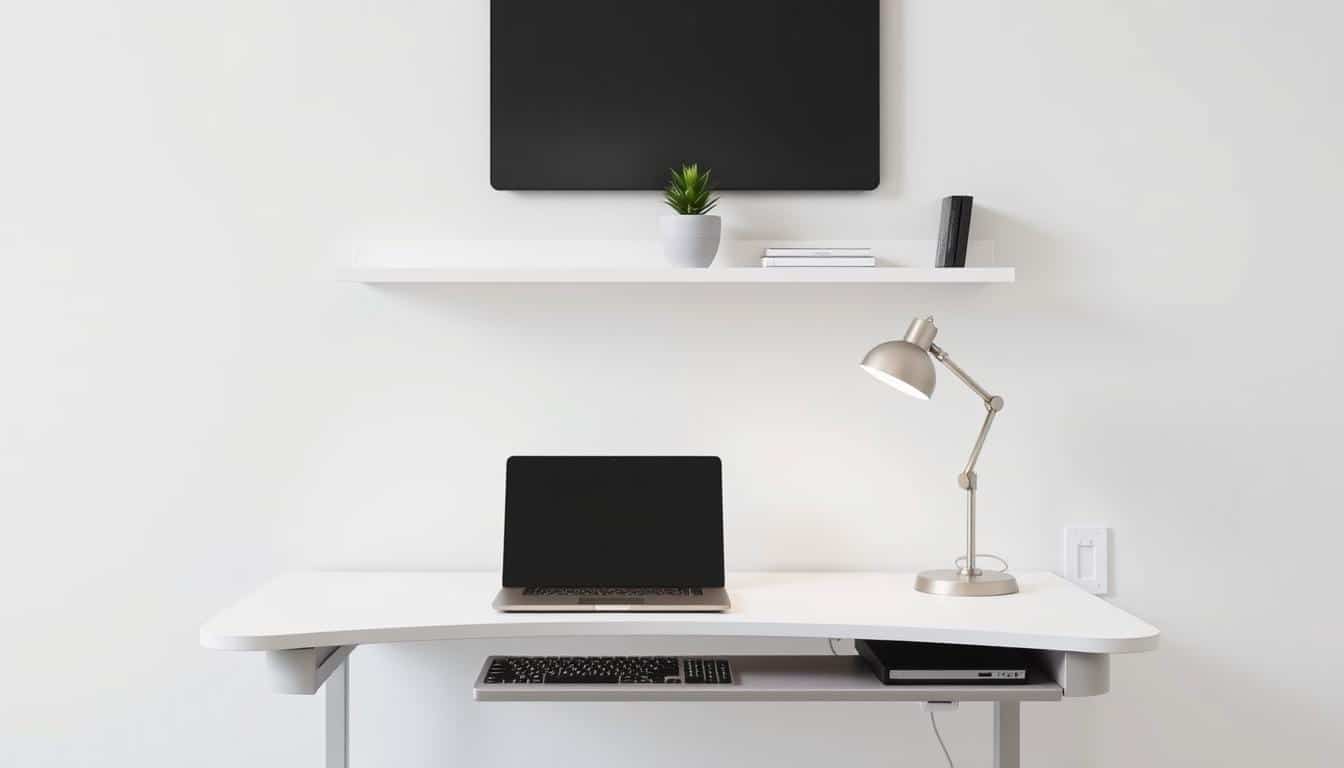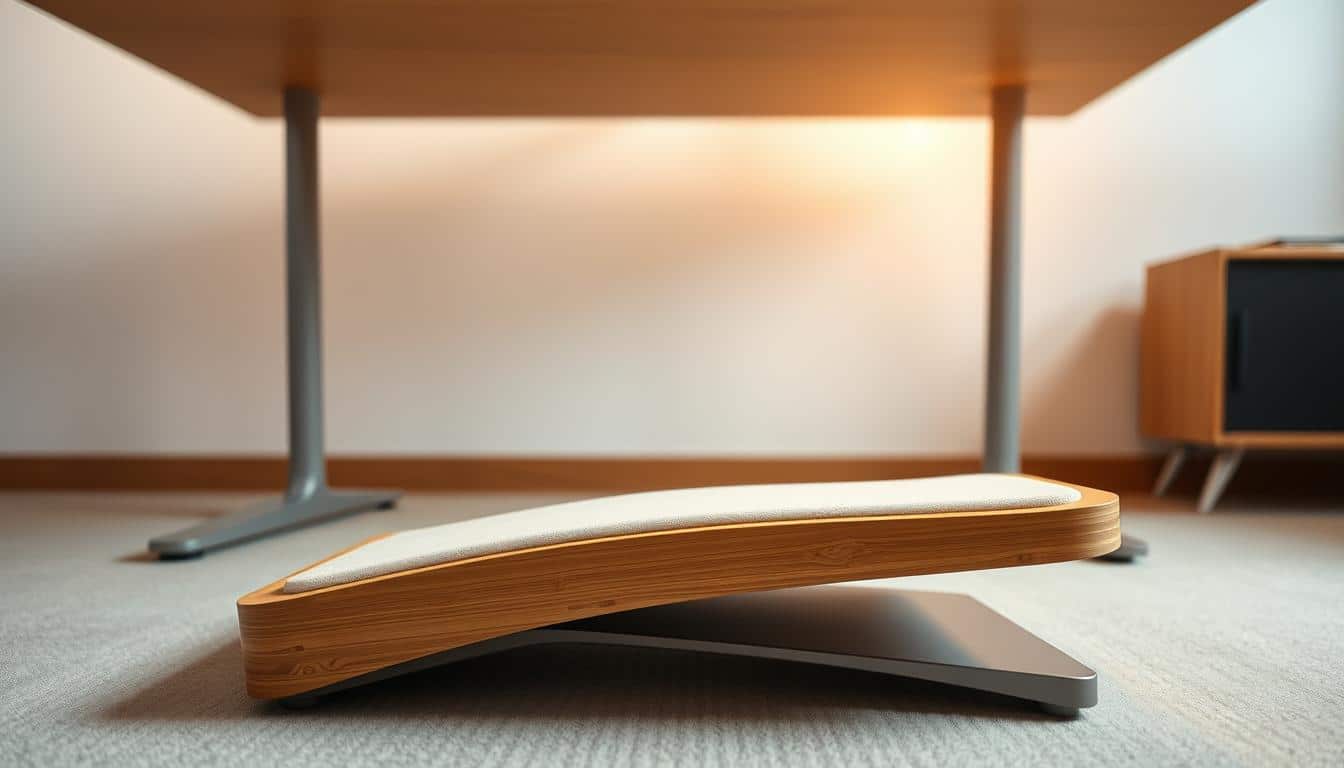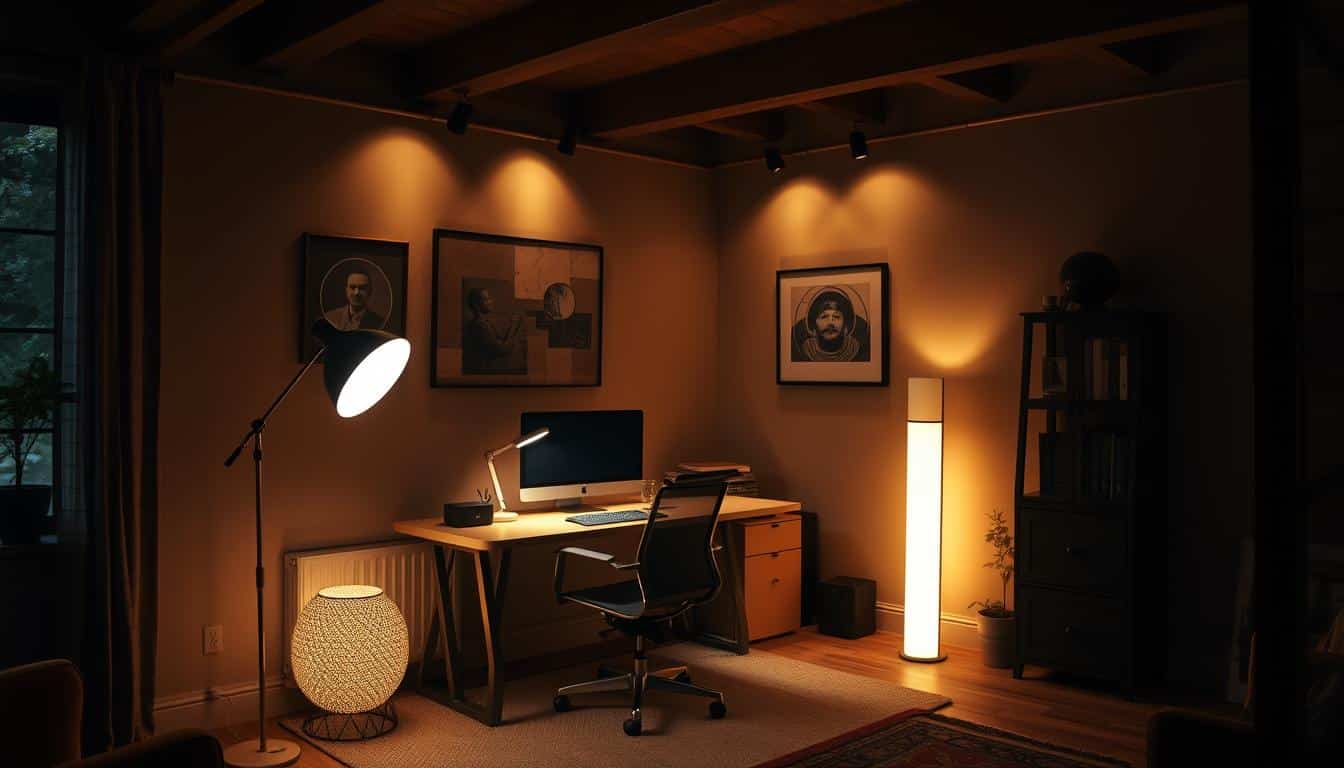Finding the perfect ergonomic keyboard for a narrow desk boosts productivity and comfort. Many experts see the value of small ergonomic keyboards, especially in tight spaces. We will look into the top ergonomic keyboards for small desks. We’ll cover their special traits, benefits, and tips to improve your typing without losing space.
Understanding Ergonomics in Keyboards
Keyboard ergonomics focuses on making typing more comfortable and reducing strain. It has grown since the 1920s to prevent repetitive strain injuries. Today, manufacturers strive to make keyboards that support ergonomic typing.
Ergonomic keyboards often have split layouts, curved shapes, and different key placements. These features help users keep a natural hand position. This can lessen the chance of issues like carpal tunnel syndrome. Knowing about these designs can make typing for long hours more comfortable and boost productivity.

The Advantages of Using an Ergonomic Keyboard
Ergonomic keyboards are designed to lessen wrist strain. They help lower the discomfort and risk of injuries from typing a lot. These keyboards make you hold your hands right, which helps you sit better and feel better when you use a computer for a long time.
Using an ergonomic keyboard can also make you type faster and more accurately. The keys are set up in a way that helps your fingers move better. This means you can do your work quicker and more easily, whether it’s for your job or just for fun.
These keyboards also help with shoulder and back strain. Their design helps you keep your body lined up right. People often feel less tired and more comfortable after switching to an ergonomic keyboard. This makes your work area a nicer place to be.
Features to Look for in an Ergonomic Keyboard
When picking an ergonomic keyboard, certain features make typing easier and more comfortable. These features are important:
- Split Design: Encourages natural arm positioning, reducing strain during long typing sessions.
- Tenting Options: Elevates the center of the keyboard, promoting a more neutral wrist angle.
- Adjustable Height Settings: Allows customization based on user preference, enhancing overall ergonomics.
- Cushioning for Wrist Support: Provides additional comfort, helping to alleviate pressure on the wrists during use.
Also, think about the type of keys and the keyboard layout as they impact use. Having a keyboard that works smoothly with different operating systems is key. Features like programmable keys and the ability to change them can make your experience better.
Ergonomic Keyboard for Narrow Desk: Best Fits
Choosing the right ergonomic keyboards for narrow desks is very important. These keyboards provide both comfort and function, perfect for those with little space. They are designed to fit well in small areas without losing ergonomic benefits.
When looking for a keyboard for a narrow desk, consider its ergonomic design. Compact keyboards with wrist supports or adjustable settings can improve comfort. Selecting keyboards that focus on both ergonomics and saving space can boost productivity and make working more enjoyable.
Top Picks for Ergonomic Keyboards for Narrow Desks
Finding the perfect ergonomic keyboard for a small desk boosts productivity and comfort. The Logitech Ergo K860 and the Matias Ergo Pro (2020) are great choices. Each has special features for different needs, making them ideal for small spaces.
Logitech Ergo K860
The Logitech Ergo K860 is a top ergonomic keyboard pick. Its curved design helps keep wrists in a natural position, cutting down on strain. It also has a wrist rest for extra comfort during long typing periods.
Even though it has a big layout, the Logitech Ergo K860 fits well on small desks. This lets you use space smartly while keeping ergonomic benefits.
Matias Ergo Pro (2020)
The Matias Ergo Pro (2020) is another great choice, especially for its split-layout. This design boosts ergonomic support. Plus, its tilting feature lets you change the typing angle for the best comfort.
It also has several USB ports, perfect for professionals needing more device connections. The Matias Ergo Pro is designed for those who want both comfort and functionality in tight spaces.
Design Considerations for Narrow Desks
When working with a narrow desk, it’s crucial to focus on the size and shape of your keyboard. A good ergonomic keyboard keeps your arms and wrists comfortable. This means less moving side to side and less strain if you’re typing for a long time.
For small workspaces, picking a small keyboard is key. These keyboards save space but still let you do everything you need. This means you can reach your most-used tools easily, boosting your work rate and keeping your desk tidy.
Combining a slim desk with the right keyboard means thinking about comfort and the space you have. By getting this balance right, you will have a work area that feels good and works well, without any fuss.
The Importance of Adjustable Keyboards
Adjustable keyboards are great for people who want to be comfortable while typing. They let individuals change their typing setup to fit their own needs. This means they can adjust the height, split the keyboard, or angle it to cut down on strain during long typing sessions.
When desks don’t have much room, having a keyboard you can adjust is really important. If there’s not enough space, finding the right spot for your keyboard is key to staying comfortable. Adjustable keyboards let you try different setups until you find one that feels best and keeps you well over time.
Choosing the Right Key Switch Type
Choosing the right key switch is vital for a good typing experience, comfort, and effectiveness. Knowing the difference between mechanical and membrane keyboards helps decide based on what you need and like.
Mechanical vs. Membrane Keyboards
Mechanical keyboards have individual switches under each key for tactile feedback and durability. Many typists like this because it makes typing feel responsive. There are many switch options, like Cherry MX Blue and Red, so you can find one that suits your style.
Membrane keyboards, on the other hand, have a single rubber dome under the keys. They are quieter and cheaper. While they might not feel as nice as mechanical ones, they are good for those who need silence or are on a budget. Membrane keyboards focus on basic needs rather than long-lasting feel or feedback.
Think about what you need. The choice between mechanical and membrane keyboards changes how comfortable you are and how well you remember key positions. The right choice can make you type faster and more accurately.
Common Misconceptions About Ergonomic Keyboards
Many think ergonomic keyboards are big and too costly. Yet, there are many small and affordable ones. They are perfect for tight spaces.
Switching to an ergonomic keyboard isn’t always easy. This is because they can have different layouts and key spaces. People might find adapting takes time due to these changes.
It’s important to know the truth about ergonomic keyboards. This will help you choose one that is comfy and effective.
How to Transition to an Ergonomic Keyboard
Switching to an ergonomic keyboard takes patience and practice. As you get used to a new layout, there might be a period of adjustment. Learning some tips can make this switch easier and reduce discomfort at the start.
Start using the ergonomic keyboard a little at a time. Begin with short typing periods. Doing this helps build comfort without causing too much stress. It’s a good way to get used to the new setup without feeling overwhelmed.
Getting to know your ergonomic keyboard’s features improves your experience. Knowing how it works makes adjusting easier. It also turns your workspace into a more efficient and comfy area.
The Role of Accessories in Enhancing Ergonomics
Adding the right ergonomic accessories can majorly boost comfort when using a keyboard. Keyboard wrist rests are key for support. They keep your wrists in a good position, cutting down the risk of pain from long typing periods.
Adjustable keyboard trays are also vital. They help adjust your keyboard’s height and angle, making it easier for people who sit or stand to find a comfy spot. This flexibility helps make a workspace that’s good for getting work done without aches.
Don’t forget about mouse pads with wrist support. They round out your ergonomic setup nicely. With these accessories, you can work more effectively and keep discomfort and injuries at bay.
Conclusion
Choosing the perfect ergonomic keyboard for small desks is key. It makes your work area more comfortable and helps avoid injuries. Key features like design, how you can adjust it, and the types of keys are important. They help find the best fit for your needs.
Getting the right ergonomic tools can change how you work every day. They support good typing habits and boost how much you get done. Whether you need something small or with special keys, there’s a perfect keyboard for your limited space.
The right choice leads to a better, happier work setting. It lets you concentrate on your work, free from pain that comes with long hours of typing. Look after your health and think about how an ergonomic keyboard can make working both comfier and more efficient.



